| dc.contributor.author | Prangenberg, Julian | |
| dc.contributor.author | Aasly, Jan | |
| dc.contributor.author | Doberentz, Elke | |
| dc.contributor.author | Madea, Burkhard | |
| dc.contributor.author | Schrader, Harald | |
| dc.date.accessioned | 2021-09-23T06:23:13Z | |
| dc.date.available | 2021-09-23T06:23:13Z | |
| dc.date.created | 2021-07-22T17:25:59Z | |
| dc.date.issued | 2021 | |
| dc.identifier.citation | Forensic Science, Medicine, and Pathology. 2021, 17, 1-6. | en_US |
| dc.identifier.issn | 1547-769X | |
| dc.identifier.uri | https://hdl.handle.net/11250/2780603 | |
| dc.description.abstract | Factitious disorders (FDs) are well known to a majority of physicians; however, the corresponding ICD-10 diagnosis F68.1 remains severely under assigned and often misdiagnosed. Based on a previously conducted nationwide survey in Germany, we extended the analyzed variables to further understand FD characteristics. The assignments regarding the following variables in the German diagnosis-related group statistics were analyzed: residence of the patient and location of the diagnosing institution, primary referral to the diagnosing institution, reason for admission and discharge, specialty department, total length of stay, length of stay in the longest treating department, surgery performed, case mix revenue, regional type of the treating institution, and patients’ region of origin. A very distinct difference was observed in the assignment rates based on the homeland of the diagnosed patient and diagnosing institution. The assignment rate showed no significant difference across German regions. Based on our findings, a patient with FD in Germany might exhibit the following “typical” traits: A woman in her late thirties from a rural area is referred by a physician or another hospital wherein she was previously treated for more than a day to an institution for fully inpatient hospital treatment wherein she completes her treatment regularly. Dermatology, neurology, emergency, and internal medicine departments tend to be confronted with patients with FDs more often than other departments; however, surgery is performed in every fifth case. Patients are primarily treated in only one department for ~ 25 days. The case mix revenue will most probably not exceed €5000. | en_US |
| dc.language.iso | eng | en_US |
| dc.publisher | Springer Nature | en_US |
| dc.rights | Navngivelse 4.0 Internasjonal | * |
| dc.rights.uri | http://creativecommons.org/licenses/by/4.0/deed.no | * |
| dc.title | Factitious disorders in Germany–a detailed insight | en_US |
| dc.type | Peer reviewed | en_US |
| dc.type | Journal article | en_US |
| dc.description.version | publishedVersion | en_US |
| dc.source.pagenumber | 1-6 | en_US |
| dc.source.volume | 17 | en_US |
| dc.source.journal | Forensic Science, Medicine, and Pathology | en_US |
| dc.identifier.doi | 10.1007/s12024-021-00395-9 | |
| dc.identifier.cristin | 1922440 | |
| cristin.ispublished | true | |
| cristin.fulltext | original | |
| cristin.qualitycode | 1 | |

